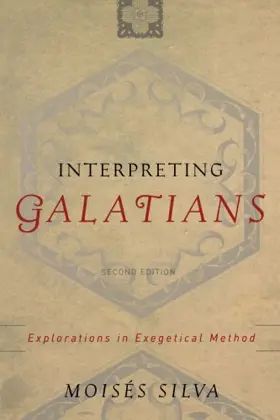

Interpreting Galatians: Explorations in Exegetical Method
Pages
256 pages
Publisher
Baker Academic
Published
1/1/2001
ISBN-13
9780801023057
Collections
This book appears in the following featured collections.
- Non-Western and BIPOC Commentaries by Matt Quintana
- TGC: Preaching Commentaries by The Gospel Coalition
Reviews
Silva does a fine job digesting academic scholarship on Galatians (and Pauline theology more generally) for the expositor in a way that’s clear and concise. He serves the preacher with his sensitivity to exegetical, biblical-theological, and systematic-theological concerns.
[Full Review]
MoisØs Silva is a careful scholar who has spent his life teaching exegesis to seminary students, a life of experience that shines through in this second edition of his previously named Explorations in Exegetical Method: Galatians as a Test Case (1996). The name change is supposed to show the strong reliance on Galatians throughout the book (9), but the original title is more apt, since Galatians is in fact more illustrative than central to the aims of the work The book is ostensibly split into three sections aptly titled �Language and Literature, ��History,� and �Pauline Theology.� The intr oductory matters, however, cover twenty-five pages, and the epilogue and appendix cover forty pages, which are significant totals for a book of 256 pages. The introduction offers insight into some basic questions about exegesis and how to avoid certain pitfalls. For example, Silva posits that interpreters often justify their views based on whom they agree with rather than using arguments from the text itself (16). The author also raises the question of how one is to balance original authorial intent with contextualization (19), though any answer to the question is deferred until later in the book. Silva further appeals to the importance of argumentation in addition to the reputation of commentators when utilizing their works. Throughout the book assertions from the introduction are applied to the history of the interpretation or to the usage of Galatians as an illustration.
[Full Review]
According to the author in his preface to the second edition, this volume is �essentially a reprint with minor revisi ons� of the first edition, entitled Explorations in Exegetical Method: Galatians As a Test Case (1996). The change in title reflects Silva�s desire to make it cl ear that the work is �about Galatians, not superficially but through and through� (9), despite his broader concern throughout the book to explore various aspects and issues of the exegetical task using the text of Galatians by way of illustration. Thus the book serves both the needs of students of exegetical methods as well as those seeking help in interpreting particular contexts in the Galatian epistle. Much of the book�s material, including an appendix examining Paul�s use of Old Testament Scripture in Gal 3:6�14, was drawn from previously published articles written over the course of the two previous decades. The book�s cont ents are divided into three major parts: �L anguage and Literature�; �History�; and �Pauline Theology.� Part 1 inclu des chapters dealing with issues of text, vocabulary, syntax, and discourse and literary structure. Part 2 concerns itself with problems of historical reconstruction, the relationship of Galatians to the book of Acts, and the dating of the epistle.
[Full Review]
The title of the 2001 Second Edition of Silva’s 1996 original monograph is, in itself, quite likely the most significant revision of the book. Originally published under the title Explorations in Exegetical Method: Galatians as a Test Case, the new edition is, in the words of the author, “essentially a reprint with minor revisions.” The revised main title Interpreting Galatians underscores the author’s insistence “that the book really is about Galatians, not superficially but through and through” – a point that the author feels was easily overlooked in the subtitle of the original publication. At the same time it must be said that the book really is about exegetical method, which Silva approaches in an extended Introduction and three major parts dealing with Language and Literature, History, and Pauline Theology, respectively. The Introduction, in which Galatians is featured only anecdotally, engages with the more general debate over original meaning versus contextualization and seeks to draw pertinent lessons from the history of exegesis. In particular, Silva pleads for a more positive reevaluation of the character of premodern hermeneutics. Citing examples from John Chrysostom, Tertullian, Irenaeus, and Thomas Aquinas, he argues that the value of these early hermeneutical approaches [to Galatians] lies not in the way that the biblical text was expounded but rather in the way the text was being used, vis a vis for polemical purposes. The lesson, according to Silva, is that these early interpreters of scripture recognized both the importance of historical meaning (authorial intent) and the need for relevance (contextualization). Part 1 of the main body of the book addresses the role that language and literature play in the interpretation of the text. Silva discusses this topic in four chapters dealing with specific issues of text, vocabulary, syntax, and discourse and literary structure. He attempts to strike a balanced approach, sounding a warning on the one hand about the need to distinguish between linguistic research and exegetical work, and on the other hand sounding a plea for the full integration of both exercises into an overall ‘hermeneutical circle/spiral.
[Full Review]


